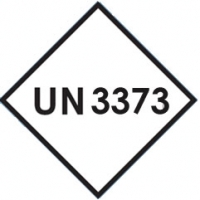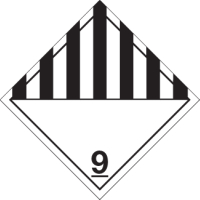Transportation of Category B infectious substances assigned to UN 3373:
Summary of Key Requirements
Classification
Proceed only after confirming material falls under the following descriptions:
- It is an infectious substance that does not meet the criteria for inclusion in Category A
- and it has no other hazardous properties (toxic, radioactive etc)
For air transport - also check state and operator variations in Appendix 8 of transport guidance since some states (countries) and operators (airlines) place additional restrictions or constraints on certain shipments.
Packing
Category B infectious substances assigned to UN 3373 must be packed in accordance with:
- for road transport - ADR Packing Instruction 650 (MS Word
 , 16kb)
, 16kb) - for air transport - IATA Packing Instruction 650 (MS Word
 , 16kb)
, 16kb)
Packing procedures that meet the packing requirements of both the above Packing Instructions are detailed below.
Packaging for Category B infectious substances is not required to be UN-type approved providing it is suitable for its purpose and capable of passing a 1.2 metre drop test. This means that following a drop from a height of 1.2m there is no leakage from the primary receptacle and this should remain protected by the absorbent material within the secondary packaging.
For transport by road there are no limits on the quantity of materials contained within either the primary receptacle(s) or the total package. This is in contrast to transport by air where (other than for body parts, organs or whole bodies) on both passenger and cargo aircraft there is a 4L/4Kg limit per package, with a 1L limit per primary receptacle for liquids whereas for solids the primary receptacle must not exceed the outer packaging mass limit of 4Kg.
Labelling
The package must be appropriately labelled and should ideally show emergency contact details that can be used in the event of a query. Label as follows:
- Packages should be clearly labelled with the delivery address and senders details with emergency contact details including a named person, at both where the package is being sent from and where it is going to, and a telephone number.
- Mark with the proper shipping name in letters at least 6 mm high BIOLOGICAL SUBSTANCE, CATEGORY B
And adjacent display the following mark:
The mark is in the form of a square set at an angle of 45° (i.e. diamond shaped) with each side having a length of at least 50 mm, the width of the line has to be at least 2mm and the letters and numbers at least 6mm high. The background of the mark has to be a contrasting colour to the surface of the package.
Note: for Category B infectious substances, the above diamond does not contain either the biohazard sign or the number 6.
- Labels must be durable and legible and clearly visible on the outside of the packaging.
- Any unnecessary or incorrect labels must not be shown on the outside of the box. For example, a box that is pre-printed for infectious substances should not be used if it does not contain these, or if a box has been used before and shows labels that are not relevant to the particular consignment this also should not be used or the labels must be removed or covered up.
- For materials on dry ice
where the package contains dry ice and is transported by road
Mark with the words DRY ICE
The UN number and associated hazard label are not required.where the package contains dry ice and is transported by air
Mark with the UN number and proper shipping name and the net weight of dry ice UN 1845 DRY ICE ## KgNearby, affixed to the same surface, the hazard warning label for Class 9 - Miscellaneous dangerous goods must be added, as shown below. This must be set at an angle of 45° (diamond shaped), at least 10 cm by 10 cm in size, have black text etc on white background, and a line 5mm inside the edge running parallel to it.

- If a thermal 'overpack' is used, it should be marked with the word "OVERPACK"
- Packages containing liquids must display "Package Orientation" labels. This must be at least 74 x 105 mm in size and show two black or red arrows on a white or suitable contrasting background. The labels must be affixed or pre-printed on at least two opposite sides to show the proper orientation for the primary(s) to be in the upright position. Note: whilst they may be used, orientation arrows are not required on packages containing Class 6.2 infectious substances in primary receptacles of not more than 50 ml.
Paperwork/Documentation
Copies of paperwork must be included within the package and also be provided to accompany the package (for the carrier). The information required must be clearly legible and for air transport must exactly meet the specified format. Paperwork (ideally this should be on University headed paper) must be included within the package between the secondary and the outer (attached to the secondary), giving:
- the names and addresses of both the consignor (sender) and consignee (receiver), including emergency contact details (name and telephone number) at both ends, and
a description of the goods in the following format:
UN 3373 BIOLOGICAL SUBSTANCE, CATEGORY B
In cases where the package will be going through customs, a statement should be added, where appropriate, that they are research materials of no commercial value.
Written emergency response procedures must also be provided with any package containing biological materials classified under UN 3373.
For transport by air it is necessary to complete an Air Waybill. Usually the airline will complete most sections- a copy of the above paperwork can be used to provide the necessary information to the airline.
The University Biological Safety Adviser must be informed of any intention by University personnel to transport (within the UK or abroad) Class 3 GMMs since advance notification must be made to the Health and Safety Executive.
Note: for goods being shipped abroad: Before sending any biological materials abroad, the person sending the goods (the consignor/shipper) should contact the person to whom they are being sent (the consignee) to let them know shipping details and to check that the substance may be legally imported. The person receiving the materials is generally regarded as the importer and the one responsible for obtaining, where necessary, all appropriate permits or licences.
Importation of materials into the United States is particularly tightly regulated and there are restrictions even on some items that may be transported as non-dangerous goods. In contrast, very few items require any sort of import permit, licence or notification to be made when importing into the UK – these are limited to certain animal pathogens or materials that may contain them, all hazard group 4 and a few hazard group 3 pathogens, and items covered by the anti-terrorism legislation. Contact the Biological Safety Adviser for advice on a case-by-case basis to check whether the item they wish to bring into the UK needs an import licence or is subject to other permissions etc.
